Be honest. How much do you cringe anytime you see the word “challenge” in a headline on your social feed?
If you’re anything like me, this usually causes you to shake your head and think Oh God, what now?
Thankfully, we’re not talking about the ridiculous Cinnamon Challenge, the Huh Challenge, or any of those other crazy stunts people take part in for some social media likes.
Instead, I’m referring to challenges that industry experts create to help others jump on the fast track to success.
These challenges serve as mini-courses designed to help readers achieve their goal in a much shorter period of time, usually within a 30, 60, or 90 day framework.
A few examples of those include:
- Shape’s 30-Day Slim Down Challenge
- Saving Toward a Better Life’s 7-Day, $500 Savings Challenge
- Creative Hive’s 30-Day A Sale A Day Challenge
- Nathan Barry’s 30-Day Audience Building Challenge
It turns out, challenges like these can help both your target audience grow as well as your business, which is why I’ll be spending our time today showing you how that’s done.
We’ll uncover how to create a challenge that drives traffic, increases engagement, and helps your target audience along the way.
By doing this, you’ll create a win-win situation for both your target customer and your business.
Before we jump right into discussing how to create and implement these challenges, let’s take a look at why doing so is worth the effort in the first place.
Here’s Why Challenges Work So Well
Most content creators share the following goals:
- To engage their audience, and
- Create a community of like-minded individuals
Well, creating a challenge of your own can help you tackle both of those at once.
Here’s how and why that works so well.
Challenges Are Attractive
Challenges stand out above other types of content. Sometimes even before your audience even sees any other content.
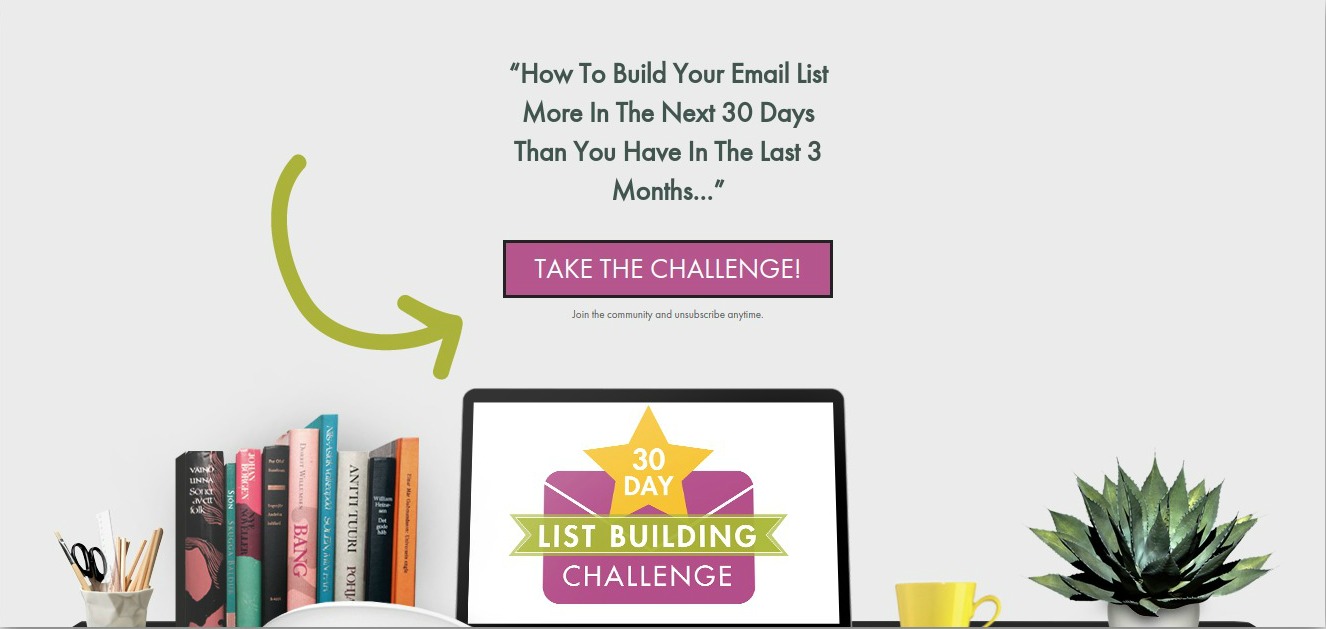
In this example, the challenge takes up the entire space above the fold. So anytime someone lands on this site, they can’t help but see this huge offer.
This instantly captures attention and starts the engagement process.
How much engagement you ask?
When I spoke with Nathalie Lussier, the brains behind this 30 day challenge, she mentioned that, over the course of 4 years, this free challenge has brought in over 55,833 subscribers.
Lussier admitted that most of the traffic has come in “spurts” thanks to hosting a live round of the challenge (more on this later) but that she also routinely sees around 20 signups per day.
Part of the reason she continues to see subscribers rolling in like this is because she’s proven that she’s the expert on the topic. And that’s another reason why challenges work so well.
Challenges Allow You to Showcase Your Expertise
When you’re creating content on a weekly or bi-weekly basis, you’re proving to your audience that you are the expert.
And by sharing this knowledge with your audience free of charge, you’ll make it that much easier for them to trust you.
In turn, they’ll continue looking to you for answers and information on the topic.
So when you hand them a nicely wrapped challenge, they’ll be more inclined to sign up right away since they already know you can help.
Plus, by signing up for a free challenge, your readers will have access to your expert level tips without paying the high price tag which means they’ll be more inclined to do so.
This helps existing users move further into your funnel without them even realizing it’s happening. It also helps you separate your browsers from your real potential customers as I’ll show you next.
Challenges Help Qualify Leads
Challenges also help you segment your list so you can qualify leads more effectively.
Eventually, you can divide your list into the following two segments:
- Those who completed the challenge
- Those who didn’t
As you can guess, those who completed your challenge are much more serious about the topics you’re covering.
Not only that, they’re probably eager to learn even more from you.
This becomes the perfect segment to focus your attention on.
And it’s one that you may not have uncovered had you not created a challenge.
The reason this works so well can be found in this next point.
Challenges Motivate And Spur Action
If your challenge conveys how you can help your readers, they’ll be motivated to take action.
See, challenges require your followers to actively take part in the content to get the full value from it.
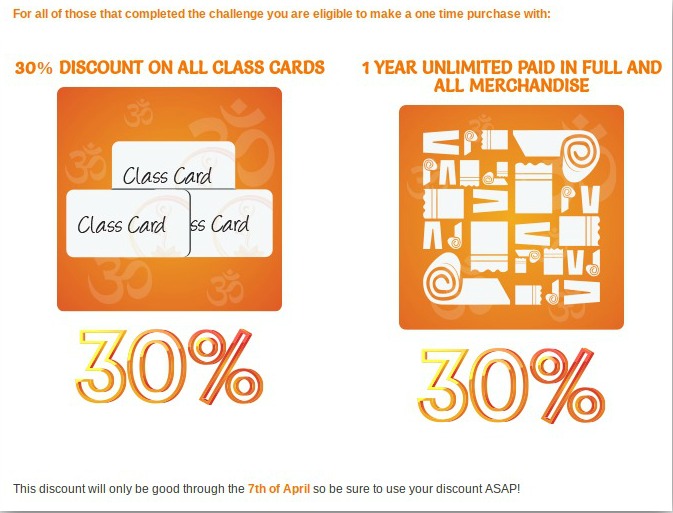
And while they’re busy solving their problem, you’re transforming previously unqualified leads into high-probability prospects.
Not only that, but those who successfully complete your challenge - and begin to see results from doing so - may be more willing to share their accomplishments (and your content) with their network. This can help you grow your traffic exponentially.

And all of this leads to the next promising point.
Challenges Can Increase Traffic and Sales Numbers
Creating challenges or guided experiences can drive an incredible amount of traffic to your website.
By promoting them on your favorite social media channels, you can turn loyal social followers into newly subscribed readers just from adding a challenge to your site.
This helps drive more traffic to your site while also increasing your conversion rates.
The best part is challenges can work no matter what stage your business is in.
If you’re just starting to build your audience, you can use them to showcase your expertise and build your email list.
In turn, you’ll be able to keep your new followers up to date regarding new releases and improvements to your current products or services and keep your brand top-of-mind.
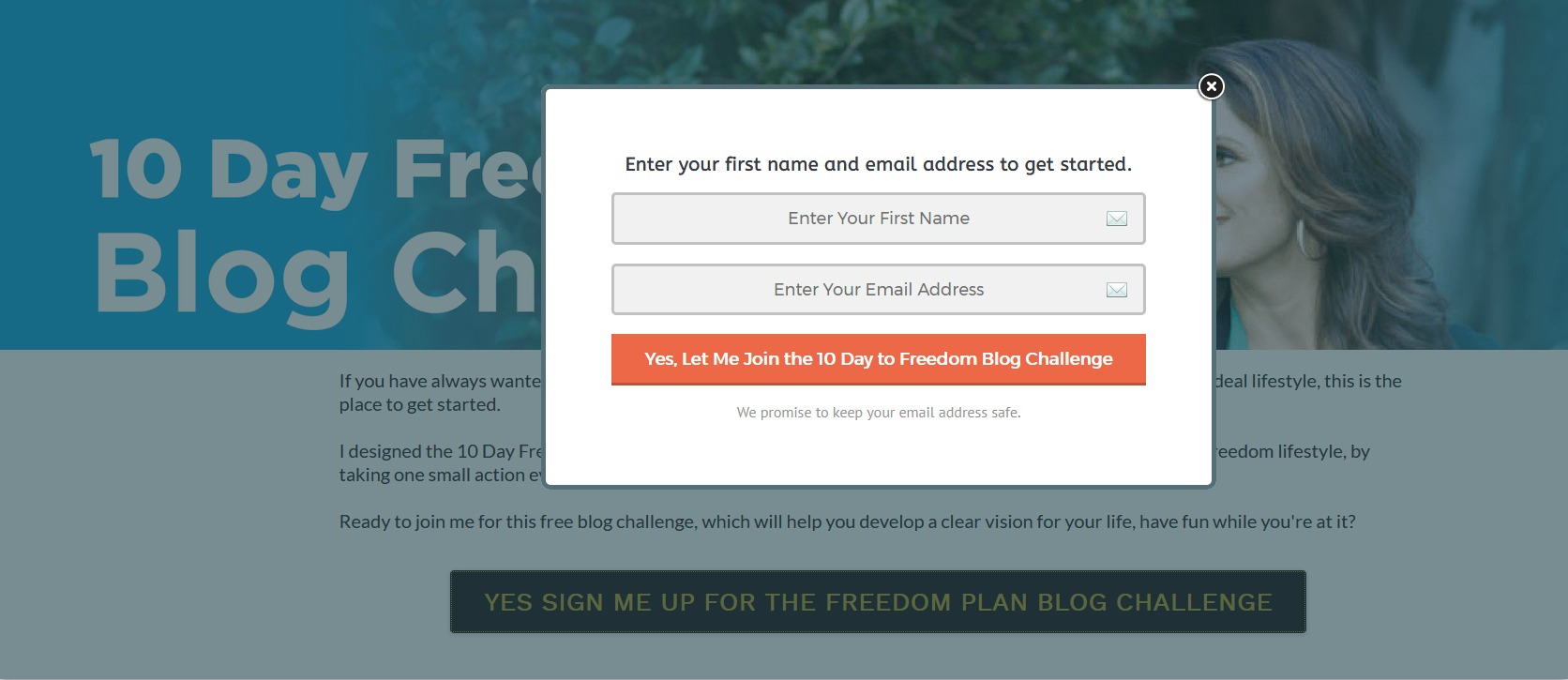
If you already have an existing list yet you’re unsure of who really needs your services, you can use a challenge to weed people out and qualify leads as I mentioned earlier.
Maybe your site is already getting a ton of traffic, but your sales numbers are still low - and your bounce rate is sky high. By getting your site in front of the right people, you’ll increase the probability of making a sale with every new visitor you earn.
Or, if you already have a steady base of clients, a new challenge can help reinvigorate them and prepare them for your next paid offer.
Once your audience sees that you’ve grown in terms of your expertise, they’ll trust that your newest offer isn’t just a rehashing of an old product or service, and will be more likely to check it out.
So...how do you create a challenge that can help you accomplish one (if not all) of these goals?
Keep reading...
5 Steps to Creating Challenges that Drive Traffic and Leads
Are you up to the task of creating your first online challenge?
Good.
In this next section, I’ll go through:
- What to think about before you start planning your challenge
- What needs to be done next
- How to create a game plan that ensures success (both your audience’s and your own)
- How to think like an educator when putting together your challenge’s content
- How to distribute and promote your challenge
Step 1: Consider Your Audience’s Goals for the Challenge
Since challenges help your audience members go from point A to point B in terms of knowledge, skills, and abilities, it’s essential that you have a clearly-defined vision of where you want them to be by the time they complete your course.
Essentially, you need to map out their challenge journey.
To make this vision clear, take a look at what your audience has already expressed interest in.
Think about things like:
- The questions they ask in the comments on your articles
- The responses you’ve received to questions you’ve asked via social media, email blasts, and forum posts
- The content you’ve created that’s generated the most buzz (social sharing, comments, etc.)
But don’t just consider the information your audience has overtly provided you.
Think about the things your audience is missing or not understanding about a certain topic.
Remember: your audience doesn’t know what they don’t know.
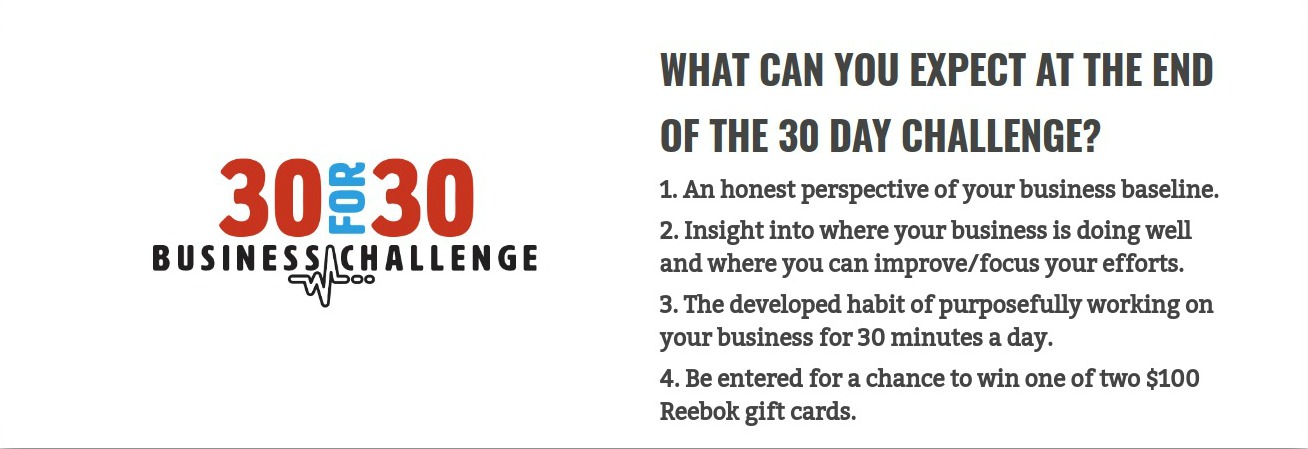
In other words, when defining your audience’s goals for the challenge, think of how finishing the challenge will benefit them, rather than simply what they’ll accomplish by meeting the challenge.
For example, your challenge might be “The Lose 10 Pounds in 30 Days Challenge,” where the goal is straightforward.
But shedding ten pounds is only part of the reason people would take on this challenge. Some might want to feel more comfortable in their own skin. Others might want to dive into a fitness regimen. Still others might want to begin adopting healthier eating habits.
In this example, if you focused only on the goal of losing ten pounds in a month, you’re setting your audience - and yourself - up for failure. Some might not lose the weight. Some will, and put it right back on. Some will lose the weight, and think “So what?”
On the other hand, by focusing on what accomplishing the challenge will mean to your audience, they’ll see your challenge for what it is: not as the be-all end-all, but as a stepping stone to greatness.
While you should definitely focus on creating a challenge that will help your audience members grow, you also want to keep in mind how you intend to use it as leverage for your own growth, as well.
Think About Your Goals for the Challenge Too
If you want your challenge to be a huge success, you need to create it with a specific goal in mind.
When setting this goal - just as you did with your audience - consider where you currently are, and where you’d like to be in the near future (as well as where you’d like to be able to go from there).
Are you just getting your company started, and don’t have much of an audience yet?
Or do you have a decent-sized email list, but a relatively low conversion rate?
Or, is everything going so well that you’re ready to introduce a new service?
In the first instance, your goal might be to drive traffic - any kind of traffic - to your site.
With the second, you’d want to focus on driving more qualified leads to your company.
As for the third, you’d want to ensure your audience is ready for what you have in store.
See how different each goal is?
When defining your goal(s) for your next challenge, make them SMART:
- Specific: What do you want to accomplish? Why do you want to accomplish this?
- Time-Based: How long will it take to achieve the goal? What should I have done or accomplished one week, one month, or one year from now?
- Relevant: Will attaining this goal benefit your company in a meaningful way? What will you be able to do once you achieve the goal?
- Attainable: Make sure your goal is realistic by considering average performance standards in your industry
- Measurable: Create a milestone (e.g., “Grow my email list to 500 people,” or “Increase conversion rate by x%”)
Mei Pak shed some light on how she developed her Sale a Day challenge with such SMART goals in mind:
“Instead of doing a smaller challenge (usually 7 days), I went all in for a 30 day challenge. 30 days worked out for me because it was enough space and time for me to teach a lot about what I knew. I could touch on every little subtopic briefly throughout the 30 days. I also wanted to attract the type of audience that knew it takes time to build a business online. A 30 day challenge helped me set the tone that we're in it for the long haul.”
After you’ve uncovered the real purpose of your challenge (both in the eyes of your audience and your brand), you’re ready to begin planning how the challenge should be implemented.
Step 2: Consider The Logistics and Implementation of Your Challenge
Now that you’re confident an online challenge will be well-received by your audience - and that it will help you accomplish your goals - you’ll need to think about:
- How you’ll deliver the challenge
- The material and content you’ll create for the challenge
- The cost of creating and delivering this content
Delivering Your Challenge
When it comes to delivering your online challenge, you have at least a few options that will depend on:
- How you want to release the material to your audience
- How you want your audience to engage with the material
- How your audience wants to engage with the material
Say, for example, you decide to post your challenge’s content on your blog on a day-by-day basis. This would mean anyone who already subscribes to your blog would be able to follow along with the challenge as the days go on. But, once your content is posted, your challenge will immediately be visible to anyone - regardless of whether they sign up for your mailing list or not.
You could get around this, once your challenge is “over” in real-time, by putting the material behind a signup wall so that newcomers would need to join your mailing list in order to receive the content (at which point they’d receive all of the material immediately).
If you have a good-sized audience on your social media pages - specifically Facebook, in this instance - that generates tons of engagement, you might choose to make your challenge material available there, rather than on your blog.
In this case, you can restrict access to your page in a similar fashion so that people can’t simply grab your material and disappear into the ether.
However, one of the most effective ways to deliver a challenge is via an email drip campaign.
Instead of posting your content on your social media page or blog (and subsequently eliminating a sense of scarcity, urgency, and engagement among those who are late to the show), you can use email automation.
This allows you to deliver your content on a day-by-day basis to each individual that signs up for your challenge.
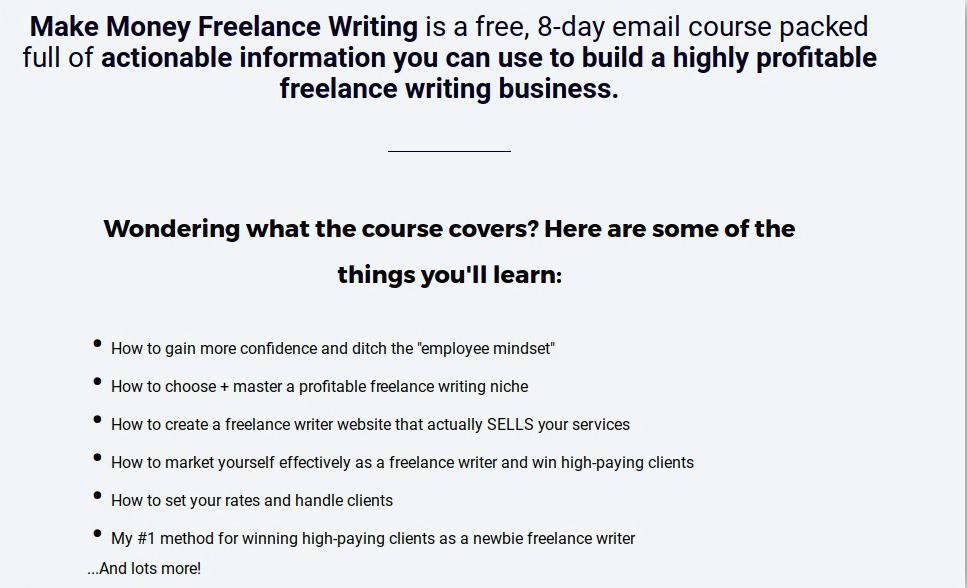
In this way, your audience members will receive the challenge material in the same manner, relative to when they signed up for the course. This will allow them to follow along at the pace you’ve determined to be best, no matter when they sign up for the challenge.
(Note: You might decide to make the material available all at once to those who complete the challenge through an email drip campaign. We’ll get into that later.)
Once you’ve determined the best methods for delivering your content, you need to actually decide what kind of content you’ll offer throughout your challenge. I’ll cover this next.
What Content Will You Offer?
While you should always strive to ensure every piece of content you offer on your blog or website is valuable to your audience, you really need to go the extra mile when creating content for your challenge.
After all, your audience is going to be pushing their limits while completing the challenge, right? If you want to set the bar high in the first place, you need to go above and beyond what your audience expects.
Furthermore, because a challenge is, by nature, comprised of multiple sessions or lessons - each of which focusing on different aspects of the overall topic - you’ll want to determine the best means of providing information and value for each session.
Remember, your challenge is never set in stone - even after it’s released.
Nathalie Lussier mentioned, “In my original challenge it was just emails and written content... But people wanted a short daily video, so I obliged and it helped me to create more of a step-by-step challenge that anyone could do.
I think when it comes to deciding what delivery method to use in your challenge, you should go with what's easiest first and iterate and make it better with future rounds of the challenge. That's exactly how I did it, and it worked really well!”
Compared to, say, a series of blog posts, each session of your challenge could consist of any of the following (and more):
- A blog post
- A podcast
- An instructional video
- A case study or customer success story
- An interview with an industry expert
- A webinar
- Extras related to specifics of your challenge (such as a checklist or calendar to track progress)
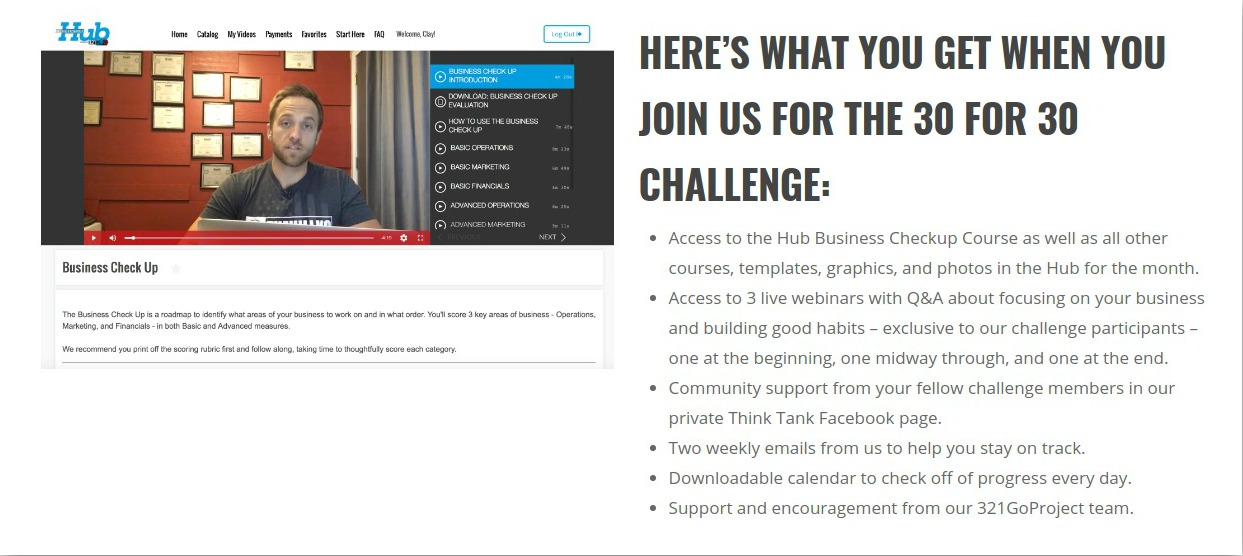
Depending on the structure of your challenge, you might also choose to offer live video chats through social media (such as Facebook or Instagram), or via other means such as Google Hangouts or Skype.
When scheduling live sessions, make sure everyone is on the same page (i.e., have either completed the challenge or are on the same step/day of the challenge).
If your audience for a single webinar or interactive live stream consists of individuals at varying stages of the process, it could be a logistical nightmare for you - and you likely wouldn’t be able to provide much value to them, either.
To make sure your audience members are all on the same page before starting up a live broadcast, make it known when the broadcast will be before you even launch your challenge.
For example, if you launch a week-long challenge at the beginning of a month, you might announce that you’ll do a live broadcast to “wrap up” the challenge at the end of that month. That way, you give latecomers a chance to complete the challenge before going live. In turn, this helps you maximize the amount of viewers your live session generates.
Of course, aside from your audience’s needs and expectations, there’s another major factor that contributes to the type of content you provide in your challenge:
Your Budget
Not surprisingly, it’s going to cost you time, money, and energy to create the content included in your challenge.
While I mentioned earlier that you want to go all-in when creating a challenge, you also need to take into consideration the cost of creating content (especially audio/visual content), the equipment and services you’ll need to purchase, create, and distribute the content, and the amount of paid advertising you plan on utilizing to promote the challenge.
As with everything in business, the main question you need to ask yourself is:
Is creating this challenge worth it?
Of course, the short answer is absolutely.
Whether your goal is to generate traffic, uncover high-quality leads, or introduce a new product or service, a well put-together challenge will certainly do the trick.
The key words being “well put-together.”
If you don’t put the necessary time, money, and effort into creating a challenge that piques (and keeps) your audience’s interest, you’ll basically end up wasting the resources you do put into it.
Step 3: Develop a Gameplan
After you’ve nailed down the logistics of creating a challenge, there’s still one more thing you need to do before you actually begin creating the content for it:
Map out the journey you want your audience to embark on.
In the world of education, this is called “scope and sequence”.
This just means you need to determine:
- Where your “students” are
- Where they want to be, and
- What you need to give them to help them get there.
To do this, revisit the goals you created for your audience and for your company.
If you haven’t already, come up with a persona for your target audience member. Assess their current level of skills and abilities, as well as their current goals, to determine:
- The focus and scope of the challenge
- The intensity of the challenge
- The length of the challenge
Once you have a general idea of the points you want to hit, how hard you want to hit them, and how long you want to spend on each point, you can then begin mapping your audience’s journey.
While it might seem intimidating to have to try to predict the future and anticipate where your audience will go, and how long it will take them to get there, you’re actually have an advantage: You’ve been on this journey, yourself!
Of course, each person’s journey to success within a specific area is going to differ in some ways but you can use your past experiences to help you plan out the general path your audience will take while completing the challenge.
Think back on your own path to success:
- What were some milestones you reached that told you things were going well?
- What roadblocks or setbacks did you face?
- What did you learn after you reached these milestones, roadblocks, or setbacks?
- What would you do differently if you could start all over?
Now, back when you were going through this “challenge” yourself, you may not have really noticed these peaks and valleys - as you may not have had a frame of reference.
But with you as a guide, your students will be able to recognize moments in which they’re about to reach a breakthrough - or times when they’re about to get caught in a snag.
Not only will they be able to anticipate these moments, but you will, as well.
In turn, you’ll be able to provide the support your audience need to push through the challenge, rather than abandon it altogether.
So when mapping out your audience’s journey, ensure the path is as smooth as possible. In other words, you want to make sure each lesson and activity flows seamlessly into the next one - creating a continuum of learning for your students.
As the old saying goes, you need to learn to walk before you can run. So you wouldn’t, for example, teach your students how to pitch a guest post before you taught them how to generate ideas for a killer article. But, by teaching them first how to brainstorm and validate their content ideas, they would then have a foundation on which to build even more knowledge about what to do with their content ideas.
Once you have an overall idea of how you want your challenge to play out, you can dive into creating each individual session for the challenge.
Step 4: Create Content For Your Challenge
When creating individual pieces of content for your challenge, don’t forget to adapt the mindset of a teacher as I mentioned earlier. This allows you to create cohesive, logically-flowing lessons that keep your audience engaged.
Regardless of whether you’re creating a blog post, podcast, video, or other piece of content, your lesson should follow a similar format:
Review: Take a moment to go over what your audience learned in the last session. This will not only jog their memory, but will also get them in a “learning and doing” state of mind.
Preview: Tie your review of yesterday’s material into how they’ll use what they previously learned while completing today’s mini-challenge (and beyond).
Direct Instruction: This is the “meat” of your daily content. At this point, tell your audience exactly what they need to do, and provide numerous suggestions regarding how they can accomplish the task(s) at hand.
It’s important during this portion of the lesson to not glance over certain things that, to you, are second nature by now - as this could confuse or overwhelm your audience, and possibly cause them to quit.
Daily Challenge: Once you’ve shown your audience how to do something new, it’ll be their turn to take a stab at it. Make your assignment - and their goals for the assignment - specific, measurable, attainable, relevant, and time-based.
Since you’ll be releasing a new session the very next day, it’s important not to pile too much on your students in one sitting. Remember, you want them to come back tomorrow!
Evaluation/Assessment: Give your students a way to evaluate their progress, both in terms of the current mini-challenge and the challenge as a whole.
Revisit the milestones and roadblocks you’ve addressed earlier, and make your audience aware of both.
The most important thing to stress here is that your audience needs to be honest with themselves in terms of their knowledge, skills, and accomplishments; but they also need to be realistic with regard to their expectations. Just like those annoying infomercials always say: results are not typical.
While some individuals may immediately experience success, others might not. In either case, your audience needs to understand the importance of pinpointing what is going right, what is going wrong, and how they can tweak their efforts moving forward.
Tie-in and Preview Next Session: Again, tie the material you covered in this session with the skills you’ve been building throughout the challenge, as well as how it relates to the challenge overall.
To keep your audience on the hook, preview what you’ll be discussing in the following session, ensuring they understand the sequential nature of the challenge as a whole (i.e., they understand how and why the skills they learned today will benefit them during tomorrow’s lesson).
By following this blueprint for every piece of content you create throughout your challenge, you’ll know with certainty that you covered everything you needed to cover, and that you presented it in the most engaging and digestible way possible.
No matter how incredible your challenge’s content is, though, all your hard work will be for naught if you don’t know how to get it in front of the right people.
Step 5: Plan The Distribution And Promotion Of Your Challenge
Once you have all of the material for your challenge ready to go, it’ll be much easier to figure out how you’re going to distribute and promote it.
Regarding distribution, there are three main targets you want to reach:
- Currently non-committed targets
- Individuals who have registered for the free challenge
- Previous customers or those who have opted to pay for the “extras” (if offering this option)
Non-committed targets are those who probably aren’t on your mailing list as of now, but who frequent your blog or social media pages.
For this audience (who obviously aren’t currently taking on your challenge), you want to provide quick-hitting, free material such as blog posts and YouTube videos that:
- Offer sneak peeks of your challenge’s content
- Showcase success stories from those who have already completed the challenge
- Explain and exhibit what they’ll be able to do after completing the challenge
I discussed the best methods of distributing your challenge to free registrants earlier, so I’ll quickly reiterate here:
- An automated drip campaign is your best bet, as it will allow individuals to sign up for your challenge on a rolling basis. To build scarcity and urgency, you should still make it clear that the challenge’s material will only be available for a specific (and short) period of time.
- A closed Facebook group created specifically for the challenge can work in similar fashion, and can bring a sense of community to those taking on the challenge. Again, though, certain individuals will be at different levels of the challenge at different times - but, depending on your preferences and your purposes for creating the challenge, this isn’t necessarily a bad thing.
- An open forum, such as your blog, may not drive nearly as many subscribers as the above options. But if you’re just getting started in your industry, it will allow you to exhibit your expertise without pandering for signups from individuals who may or may not trust that you’ll provide value to them.
Lastly, you might choose to offer a paid option for those who really want to dig into your challenge. Some of the things you might choose to include in the paid version of your challenge are:
- Immediate and open access to all course material
- Supplemental content (such as templates, scripts, and checklists that you use in your professional career)
- Access to an elite community of highly-focused individuals (via Slack for example)
- 1-on-1 mentoring sessions
- Previews of or offers to beta test future products or services
Such an offer goes above and beyond the scope of this guide, but it’s a good thing to keep in mind in case your free challenge really takes off in terms of traffic and engagement.
To promote your challenge and get it in front of the right eyes, you have a few options:
- Social Media
- Guest Posts
- Landing Pages
Let’s start with the easiest: social media.
Social Media
Check out how Sarah Smith promotes her “Sew Together for the Summer” challenge:

Whether she posts this on Twitter, Instagram, or Pinterest (along with a link in the caption, of course), interested individuals will instantly know what hashtag to follow, what accounts to check out, and how long they have until registration closes.
For those interested in sewing over summer break, this post hits everything they could need.
As you’ll see next, your existing audience is also a great place to start.
Use Your Existing List
Though your goal when offering a challenge is to grow your mailing list, you can also use your existing list as leverage.
Let your subscribers know you’ve recently created a challenge, include reminders to sign up in your regularly-scheduled email blasts, and ask your current audience to recommend the challenge to anyone else who may be interested.
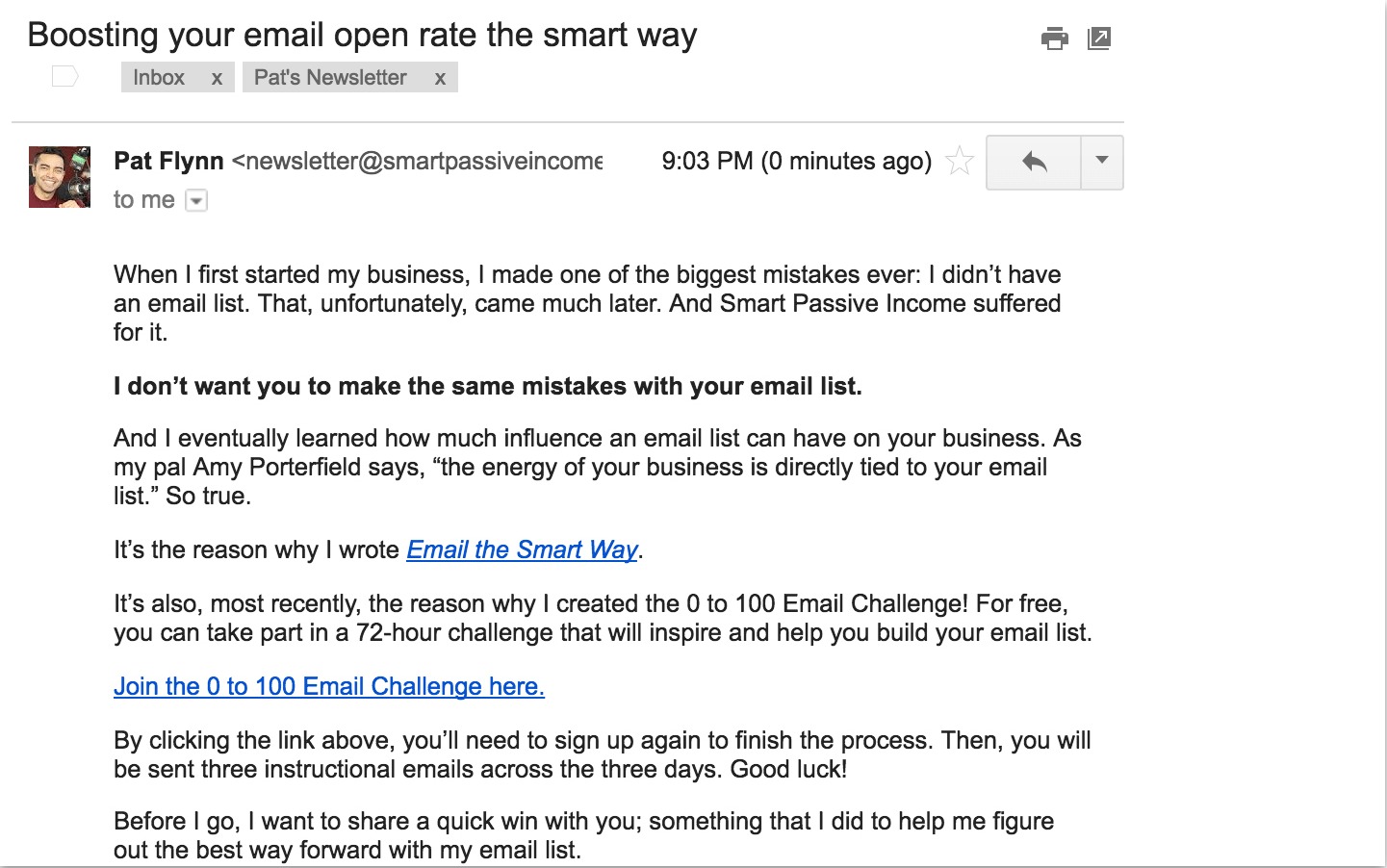
Pat Flynn does a great job of this when he lets his subscribers know about a 72-hour challenge that’s connected to the email he just sent out. This is the perfect way to show readers if you liked this piece of content, you’ll love this challenge I created.
Asking for referrals via email can also help you create an “ask” that becomes tough for your loyal followers to ignore.
For those still in the planning stage, solicit input from your audience to uncover new topics to cover in your material.
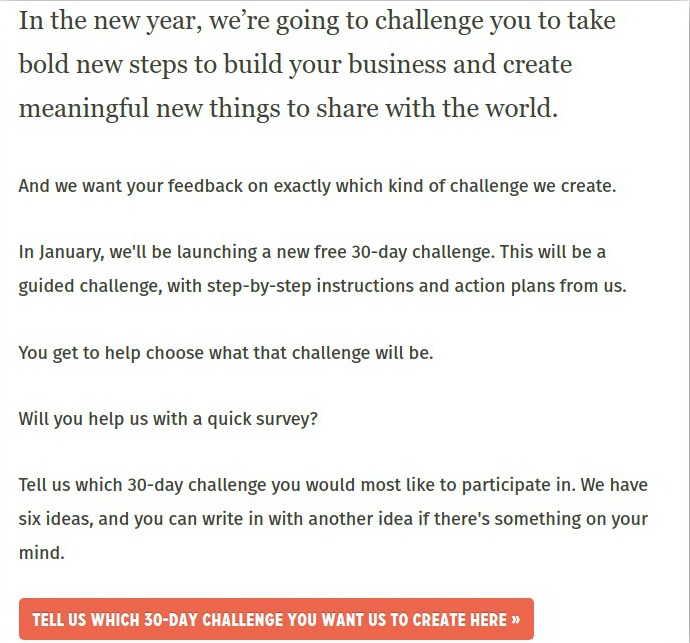
You don’t necessarily need to be overt, though. Use what you’ve learned from past customer surveys, conversations, and other touch points to gauge your audience’s potential interest in a challenge topic and - more specifically - how you can provide value to them through such a challenge. To reach those not already on your mailing list, there are a few other things you can do. Guest posting is another effective way of generating traffic to your site - especially when you have a challenge to offer. For example, if your challenge involves saving a certain amount of money over the course of a year, you might pitch a guest post to The Penny Hoarder regarding “X Stupid Simple Ways to Save Money on a Daily Basis.” You’d then ask for a link to your challenge’s landing page to be placed in your bio, allowing interested readers to check out what else you have to offer. Here’s an example of what that looks like:Guest Posting
Speaking of landing pages, you do have one to capture leads that participate in your challenge, right?
Landing Pages
I showed you this one earlier as an example.
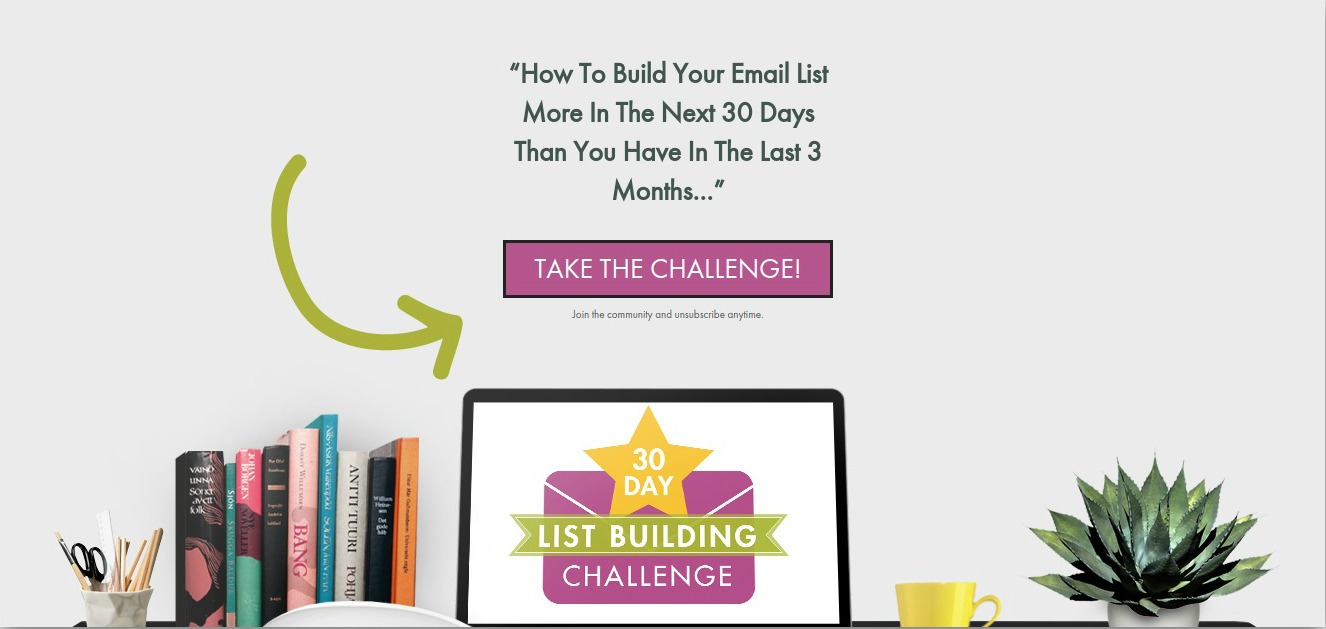
Put simply, a landing page ensures that the first thing anyone sees when they come to your site is information about your challenge - and a prompt to sign up for it, as well.
To make yours an effective landing page, you’ll need:
- An attention-grabbing headline and descriptive subhead
- A “hero shot” representing successful use of the skills learned through the challenge
- A data collection form (asking, in this case, for your visitor’s name and email address)
- A call to action
- A list of benefits your visitor will reap upon completing the challenge
- A secondary call to action (such as a link to your challenge’s social media page)
You can implement your challenge’s landing page throughout your website depending on the specific page an audience member visits.
For example, if your challenge focuses on helping people build a garden in 30 days, you’d want your landing page to appear if a visitor clicked on a post from your blog titled 5 Things to Know Before Starting Your Garden.
By creating a landing page focused entirely on promoting your challenge, you ensure that anyone who visits your site who may be interested in your challenge will understand exactly what it’s all about - and what they can gain by signing up.
Instead of spending countless hours creating the perfect landing page, you could reach for Welcome Mat instead.
With this form, you’ll be able to create a full-screen call to action that shows anytime someone lands on your site. This helps you drive opt-ins to your challenge just like a landing page would. The only exception: it takes a fraction of the time to set up.
Speaking of which, it’s time to start building that challenge of yours.
Create Your First Challenge Today
Your next step is similar to your first step when creating any offer for your audience: Find out not only what they want, but what they need - what they’re dying to learn or be able to do.
If you can develop a program that helps people overcome what is perhaps their most pressing obstacle in life, they’ll surely stick around to see what else you have in store.
And - whether we’re talking about you creating a challenge or the individuals who complete your challenge - it pays to keep in mind that success doesn’t happen overnight.
So don’t give up if your first challenge turns out to be a flop. Learn from it and make your next one even better.


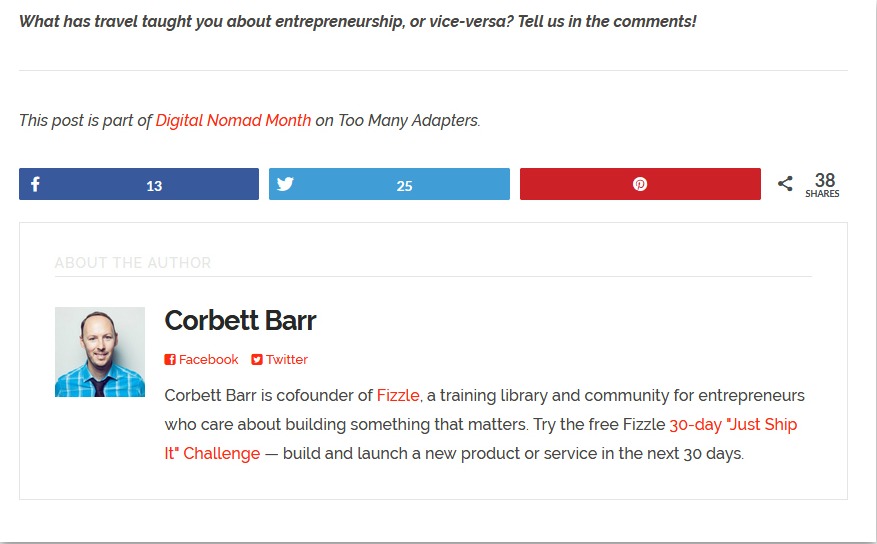
Comments